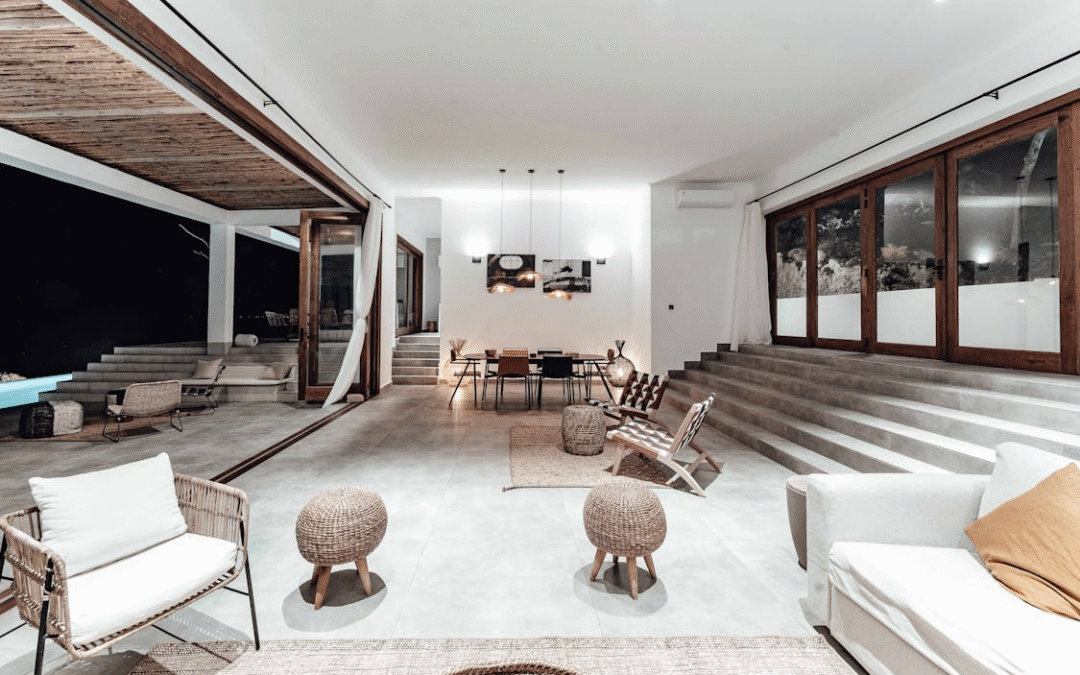Indoor-outdoor living is a design philosophy that seamlessly integrates your home’s interior spaces with the natural world outside. This concept goes beyond simply adding a patio or deck but is rather about creating a natural flow between indoor and outdoor areas. This transition allows a homeowner to expand their living space to bring the natural outdoor beauty indoors.
This design allows homeowners to make use of the most of their property, even if the size is small. Whether you have a sprawling backyard or small urban balcony, indoor-outdoor living can create a more open, airy and natural way of living.
The Rise of Indoor-Outdoor Living Spaces
Indoor-outdoor living has become a main attraction of modern home design in recent years. Several factors have led to the rise in these types of living spaces:
- Changing work patterns: With more people working from home, there’s a growing desire for flexible, multi-functional spaces that can serve as both work and relaxation areas.
- Wellness focus: An increased emphasis on health and well-being has led to a greater appreciation for natural environments and their positive effects on mental and physical health.
- Technological advancements: Improved materials and construction techniques have made it easier and more affordable to create seamless transitions between indoor and outdoor spaces.
- Environmental awareness: As people become more environmentally conscious, there’s a growing desire to connect with nature and incorporate sustainable design principles into home architecture
The versatility of this type of living has contributed to its widespread use and adoption across various types of houses and owners. From families to young professionals as well as retirees are enjoying indoor-outdoor living areas.
Key Elements of Successful Indoor-Outdoor Living Areas
To create an effective living space that will be enjoyed by everyone, several aspects need to be taken into account:
Seamless Flooring Design
One of the most important aspects of blending indoor and outdoor spaces is creating a continuous flooring surface. This can be achieved by:
- Using the same or similar flooring materials both inside and outside
- Ensuring the indoor and outdoor floors are at the same level
- Choosing weather-resistant materials for outdoor areas that complement indoor finishes
Create Large Openings
To maximize the connection between indoor and outdoor spaces, incorporate large openings such as:
- Sliding glass doors
- Bi-fold doors
- French doors with expansive glass panels
These features not only provide easy access to outdoor areas but also allow for unobstructed views and ample natural light.
Functional Outdoor Spaces
Create outdoor areas that serve specific purposes, mirroring indoor rooms:
- Outdoor kitchens or barbecue areas
- Comfortable seating arrangements for relaxation and entertainment
- Dining spaces for al fresco meals
Weather Protection
Ensure your outdoor spaces can be enjoyed year-round by incorporating:
- Retractable awnings for pergolas
- Outdoor heaters for cooler months
- Ceiling fans for hot summer days
Transforming the Heart of Your Home Into an Indoor-Outdoor Living Space
The kitchen is often considered the heart of the home, and this is true for indoor-outdoor living spaces as well. With a kitchen remodeling project, you can extend your existing kitchen to the outdoors. This can change the way you cook, entertain and enjoy meals with family and friends. Transform your kitchen into the indoor-outdoor hub of your home with the following tips:
Install a Pass-Through Window
A large pass-through window to the outdoor patio can link your indoor and outdoor areas without needing to transform your entire kitchen. This allows for easy serving of food and drinks and ensures that the food preparation area is not completely cut off and isolated, enhancing functionality of the space.
Create an Outdoor Kitchen
Consider creating a fully-equipped outdoor kitchen area to stay connected to guests and family. Your outdoor kitchen might include:
- A built-in grill or pizza oven
- Weatherproof cabinets for storage
- A sink for food preparation and cleanup
- Refrigeration units for drinks and perishables
Use Consistent Materials
Choose materials and design choices that will blend the indoor and outdoor areas of your kitchen. This can mean using the same countertop design or using the same tiles. By creating a seamless flow the two areas will feel better connected.
Design for a Seamless Flow
Ensure that the layout of your indoor and outdoor kitchen areas allows for easy movement between the two spaces. Consider the workflow when cooking and entertaining to create a functional design.
Embracing the Outdoors in Your Home
Indoor-outdoor living is more than just a design trend but is a lifestyle choice that can enhance your home. You can create a home that feels more spacious and connected to nature allowing you to be more in tune with your surroundings. By bringing nature closer to your living spaces, you can enjoy benefits such as improved mental well-being, increased physical activity, and a greater appreciation for the natural world.

